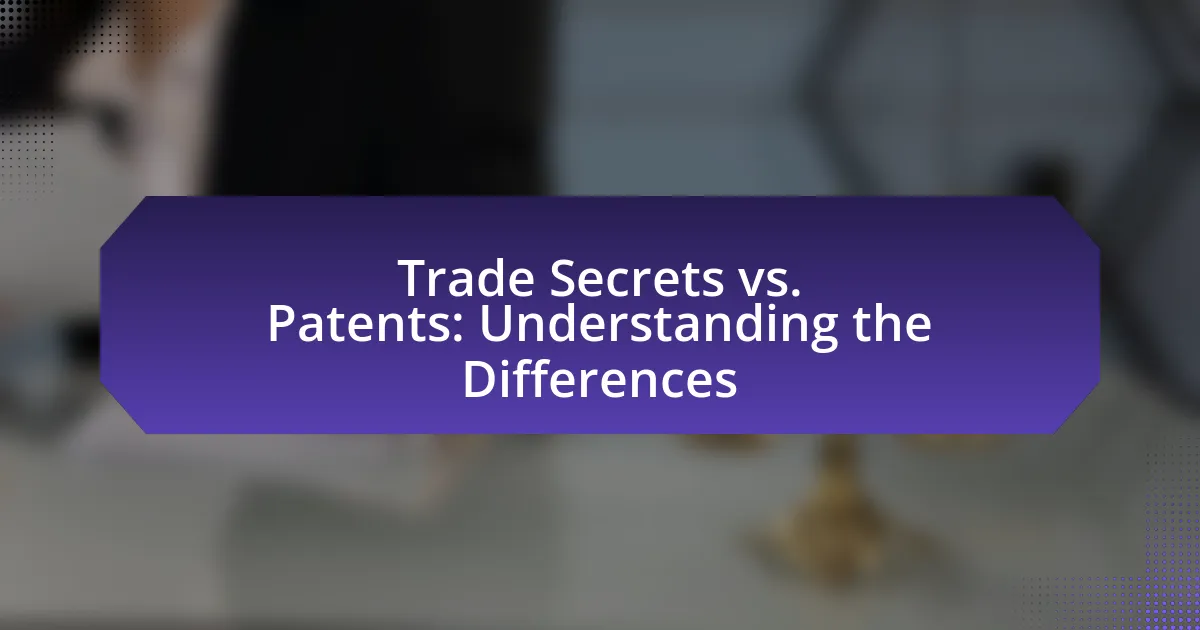Trade secrets and patents are two distinct forms of intellectual property protection that serve different purposes in business innovation. Trade secrets encompass confidential information that provides a competitive advantage, such as formulas and processes, and can remain protected indefinitely as long as they are kept secret. In contrast, patents grant inventors exclusive rights to their inventions for a limited period, typically 20 years, in exchange for public disclosure. This article explores the definitions, legal frameworks, advantages, and disadvantages of trade secrets and patents, as well as the decision-making factors businesses should consider when choosing between these two forms of protection. It highlights the importance of both mechanisms in fostering innovation and maintaining competitive advantages in various industries.

What are Trade Secrets and Patents?
Trade secrets are confidential business information that provides a competitive edge, while patents are legal protections granted for inventions, giving the inventor exclusive rights to use, sell, or license the invention for a specified period. Trade secrets can include formulas, practices, processes, designs, instruments, or patterns that are not publicly known and are maintained through secrecy measures. In contrast, patents require public disclosure of the invention in exchange for a limited monopoly, typically lasting 20 years from the filing date. The U.S. Patent and Trademark Office reported that in 2021, over 400,000 patent applications were filed, highlighting the importance of patents in protecting innovations.
How do Trade Secrets differ from Patents?
Trade secrets and patents differ primarily in their protection mechanisms and duration. Trade secrets protect confidential business information that provides a competitive edge, such as formulas or processes, without any formal registration, as long as the information remains secret. In contrast, patents grant exclusive rights to an inventor for a limited time, typically 20 years, after disclosing the invention to the public. This means that while trade secrets can potentially last indefinitely if kept confidential, patents require public disclosure and have a finite protection period.
What defines a Trade Secret?
A trade secret is defined as any confidential business information that provides a competitive edge to its holder. This includes formulas, practices, processes, designs, instruments, or patterns that are not generally known or reasonably ascertainable by others. The legal framework for trade secrets is established under the Uniform Trade Secrets Act, which stipulates that the information must be subject to reasonable efforts to maintain its secrecy. For instance, the Coca-Cola formula is a well-known trade secret, as it is kept confidential and gives the company a significant market advantage.
What constitutes a Patent?
A patent constitutes a legal right granted by a government to an inventor, allowing them exclusive rights to their invention for a specified period, typically 20 years from the filing date. This exclusivity applies to inventions that are novel, non-obvious, and useful, as defined by patent law. The United States Patent and Trademark Office (USPTO) outlines that a patent can cover processes, machines, articles of manufacture, or compositions of matter. The requirement for novelty means that the invention must not have been publicly disclosed before the patent application, while non-obviousness indicates that the invention must not be an evident improvement over existing products or processes.
Why are Trade Secrets and Patents important?
Trade secrets and patents are important because they provide legal protection for intellectual property, fostering innovation and economic growth. Trade secrets protect confidential business information, allowing companies to maintain a competitive edge without disclosing their methods or formulas. For example, the Coca-Cola formula is a trade secret that has contributed to the company’s market dominance. Patents, on the other hand, grant exclusive rights to inventors for a specified period, incentivizing the development of new technologies. According to the World Intellectual Property Organization, patents encourage investment in research and development, leading to advancements in various industries. Together, trade secrets and patents create an environment that promotes creativity and protects the interests of inventors and businesses.
What role do they play in business innovation?
Trade secrets and patents play crucial roles in business innovation by providing mechanisms for protecting intellectual property. Trade secrets allow companies to maintain a competitive edge by safeguarding confidential information, such as formulas or processes, which can lead to innovative products or services. For instance, Coca-Cola’s secret formula is a trade secret that has contributed to its market dominance. On the other hand, patents grant exclusive rights to inventors for a limited time, incentivizing innovation by allowing them to recoup research and development costs. According to the World Intellectual Property Organization, patents can stimulate economic growth by encouraging investment in new technologies. Thus, both trade secrets and patents are essential for fostering an environment conducive to innovation in business.
How do they protect intellectual property?
They protect intellectual property through legal mechanisms such as patents, trademarks, copyrights, and trade secrets. Patents grant exclusive rights to inventors for a specified period, preventing others from making, using, or selling the invention without permission. Trademarks protect brand names and logos, ensuring that consumers can identify the source of goods or services. Copyrights safeguard original works of authorship, including literature, music, and art, by giving creators control over reproduction and distribution. Trade secrets involve keeping proprietary information confidential, which can include formulas, practices, and processes that provide a competitive edge. These methods collectively help maintain the integrity and value of intellectual property in various industries.

What are the Legal Frameworks for Trade Secrets and Patents?
The legal frameworks for trade secrets and patents are defined by distinct laws and regulations. Trade secrets are protected under the Uniform Trade Secrets Act (UTSA) and the Defend Trade Secrets Act (DTSA) in the United States, which provide legal recourse against misappropriation and require that the information be kept confidential. In contrast, patents are governed by the Patent Act, which grants exclusive rights to inventors for a limited time in exchange for public disclosure of the invention. The U.S. Patent and Trademark Office (USPTO) oversees the patent application process, ensuring that inventions meet criteria of novelty, non-obviousness, and usefulness. These frameworks establish the legal basis for protecting intellectual property, with trade secrets focusing on confidentiality and patents emphasizing public disclosure and exclusivity.
How is a Trade Secret legally protected?
A trade secret is legally protected through a combination of state laws, primarily the Uniform Trade Secrets Act (UTSA) in the United States, and the Defend Trade Secrets Act (DTSA) at the federal level. These laws provide legal recourse against misappropriation, which includes theft, breach of confidentiality, or unauthorized disclosure of the trade secret. To qualify for protection, the trade secret must be information that derives independent economic value from not being generally known and is subject to reasonable efforts to maintain its secrecy, such as non-disclosure agreements and security measures. The legal framework ensures that businesses can seek damages and injunctions against those who unlawfully acquire or disclose their trade secrets, thereby safeguarding their competitive advantage.
What laws govern Trade Secrets?
The laws that govern trade secrets in the United States primarily include the Uniform Trade Secrets Act (UTSA) and the Defend Trade Secrets Act (DTSA). The UTSA, adopted by most states, provides a framework for the protection of trade secrets, defining what constitutes a trade secret and outlining the legal remedies available for misappropriation. The DTSA, enacted in 2016, allows trade secret owners to bring a federal civil action for misappropriation and provides for both injunctive relief and damages. These laws collectively establish the legal standards and protections for trade secrets, ensuring that businesses can safeguard their confidential information from unauthorized use or disclosure.
What are the requirements for maintaining a Trade Secret?
To maintain a trade secret, the information must be kept confidential, providing a competitive advantage. This requires implementing reasonable measures to protect the secrecy, such as non-disclosure agreements, restricted access, and security protocols. Courts have upheld that if a business takes appropriate steps to keep the information secret, it can qualify as a trade secret under the Uniform Trade Secrets Act and the Defend Trade Secrets Act, which define trade secrets as information that derives independent economic value from not being generally known and is subject to efforts to maintain its secrecy.
What is the process for obtaining a Patent?
The process for obtaining a patent involves several key steps. First, an inventor must conduct a patent search to ensure that the invention is novel and not already patented. Next, the inventor prepares a detailed patent application, which includes claims that define the invention, drawings, and a written description. This application is then submitted to the relevant patent office, such as the United States Patent and Trademark Office (USPTO) in the U.S. After submission, the patent office reviews the application for compliance with legal requirements and conducts a substantive examination to assess the patentability of the invention. If the application meets all criteria, the patent is granted, providing the inventor exclusive rights to the invention for a specified period, typically 20 years from the filing date. This process is supported by the legal framework established by patent laws, which aim to encourage innovation by protecting inventors’ rights.
What are the steps involved in filing a Patent application?
The steps involved in filing a patent application include conducting a patent search, preparing the application, filing the application with the relevant patent office, and responding to any office actions. Conducting a patent search helps determine if the invention is novel and non-obvious, which are key criteria for patentability. Preparing the application involves drafting claims, descriptions, and drawings that clearly define the invention. Filing the application requires submitting the necessary documents and fees to the patent office, such as the United States Patent and Trademark Office (USPTO) in the United States. After filing, the applicant may need to respond to office actions, which are communications from the patent office regarding the application’s status or required changes. These steps ensure that the application is properly submitted and evaluated for patent protection.
How long does Patent protection last?
Patent protection lasts for 20 years from the filing date of the patent application. This duration applies to utility patents in the United States, as established by the Patent Act of 1952. After this period, the patent enters the public domain, allowing others to use the invention without permission.

What are the Advantages and Disadvantages of Trade Secrets and Patents?
Trade secrets and patents each have distinct advantages and disadvantages. Trade secrets offer the advantage of indefinite protection as long as the information remains confidential, allowing businesses to maintain a competitive edge without the need for public disclosure. For example, the Coca-Cola formula has been kept secret for over a century, providing sustained market advantage. However, the disadvantage of trade secrets is that they can be easily lost through reverse engineering or employee turnover, leading to potential loss of competitive advantage.
Patents, on the other hand, provide a limited period of exclusive rights (typically 20 years) after which the invention enters the public domain, ensuring that the inventor can capitalize on their innovation. This encourages investment in research and development, as seen in the pharmaceutical industry where patents incentivize the creation of new drugs. The disadvantage of patents is that they require public disclosure of the invention, which can allow competitors to design around the patent or develop similar products once the patent expires. Additionally, the patent application process can be costly and time-consuming, potentially deterring smaller inventors.
What are the benefits of using Trade Secrets?
The benefits of using trade secrets include the indefinite protection of confidential information without the need for formal registration, which allows businesses to maintain a competitive edge. Unlike patents, which expire after a set period, trade secrets can last as long as the information remains confidential, providing ongoing advantages in the marketplace. Additionally, trade secrets do not require public disclosure, allowing companies to keep their proprietary methods, formulas, or processes hidden from competitors, thereby safeguarding their unique business strategies. This confidentiality can lead to increased market share and profitability, as companies can leverage their trade secrets to innovate and differentiate their products or services effectively.
How do Trade Secrets provide competitive advantages?
Trade secrets provide competitive advantages by allowing businesses to protect valuable, confidential information that gives them an edge over competitors. This protection enables companies to maintain unique processes, formulas, or strategies that are not publicly disclosed, thereby preventing competitors from replicating their success. For instance, the Coca-Cola formula is a trade secret that has contributed significantly to the company’s market dominance, as it remains undisclosed and thus inaccessible to competitors. By safeguarding such information, businesses can enhance their market position, foster innovation, and achieve higher profit margins without the limitations imposed by patent disclosures.
What are the risks associated with Trade Secrets?
The risks associated with trade secrets include the potential for misappropriation, loss of competitive advantage, and legal challenges. Misappropriation occurs when confidential information is disclosed or used without authorization, which can lead to significant financial losses. The loss of competitive advantage arises if trade secrets are leaked to competitors, undermining the original holder’s market position. Legal challenges may stem from disputes over ownership or enforcement of trade secret protections, which can be costly and time-consuming. According to the Economic Espionage Act of 1996, theft of trade secrets can result in severe penalties, highlighting the importance of safeguarding such information.
What are the advantages of obtaining a Patent?
Obtaining a patent provides exclusive rights to an invention, allowing the patent holder to prevent others from making, using, or selling the patented invention without permission. This exclusivity can lead to significant financial benefits, as it enables the patent holder to capitalize on their innovation through licensing agreements or by entering markets without competition. Additionally, patents can enhance a company’s reputation and attract investors, as they signify a commitment to innovation and provide a competitive edge. According to the United States Patent and Trademark Office, patents can also increase the overall value of a business, making it more appealing for mergers and acquisitions.
How does a Patent enhance market position?
A patent enhances market position by granting exclusive rights to an invention, preventing competitors from using, making, or selling the patented product without permission. This exclusivity allows the patent holder to establish a competitive advantage, often leading to increased market share and higher profit margins. For instance, companies like Pfizer have leveraged patents to secure significant revenue from exclusive drug sales, demonstrating how patents can effectively block competition and create a strong market presence.
What are the limitations of Patent protection?
Patent protection has several limitations, including a limited duration, public disclosure requirements, and the necessity for novelty and non-obviousness. Specifically, patents typically last for 20 years from the filing date, after which the invention enters the public domain, allowing anyone to use it without restriction. Additionally, the patent application process requires detailed public disclosure of the invention, which can enable competitors to design around the patent. Furthermore, to qualify for patent protection, an invention must be novel and non-obvious, meaning that not all inventions can be patented, limiting the scope of protection available to inventors.
How can businesses decide between Trade Secrets and Patents?
Businesses can decide between trade secrets and patents by evaluating the nature of their innovation and the desired level of protection. Trade secrets are suitable for information that can be kept confidential indefinitely, such as formulas or processes, while patents are appropriate for inventions that can be publicly disclosed and have a limited duration of protection, typically 20 years.
For instance, if a business has developed a unique recipe that it can keep secret, it may opt for trade secret protection. Conversely, if a company invents a new technology that can be patented, it may choose to file for a patent to secure exclusive rights and potentially monetize the invention through licensing.
The decision also hinges on factors like the cost of obtaining a patent, the likelihood of reverse engineering, and the competitive landscape. According to the World Intellectual Property Organization, businesses should assess the potential for innovation disclosure and the strategic importance of the intellectual property to make an informed choice.
What factors should be considered in the decision-making process?
In the decision-making process regarding trade secrets versus patents, key factors include the nature of the information, the level of protection required, and the potential for commercial advantage. The nature of the information determines whether it can be kept confidential or if it is eligible for patent protection; for instance, processes that can be easily reverse-engineered may be better suited for patenting. The level of protection required influences the choice, as patents provide legal rights against infringement for a limited time, while trade secrets can last indefinitely if kept confidential. Additionally, the potential for commercial advantage must be assessed, as patents can enhance market position and attract investment, while trade secrets may offer a competitive edge without public disclosure. These factors are critical in aligning the decision with business goals and legal considerations.
How do industry practices influence this choice?
Industry practices significantly influence the choice between trade secrets and patents by dictating the level of innovation, competitive advantage, and regulatory environment. For instance, industries with rapid technological advancements, such as pharmaceuticals, often favor patents to secure exclusive rights and incentivize research and development, as evidenced by the substantial investment in drug development that can exceed billions of dollars. Conversely, industries where processes can be kept confidential, like food and beverage, may prefer trade secrets to maintain a competitive edge without disclosing proprietary information. This preference is supported by the fact that trade secrets can last indefinitely as long as they remain confidential, unlike patents, which expire after a set period. Thus, the specific practices and norms within an industry shape the strategic decisions regarding intellectual property protection.
What best practices should businesses follow regarding Trade Secrets and Patents?
Businesses should implement robust confidentiality measures for trade secrets and strategically assess patent protection for inventions. For trade secrets, best practices include limiting access to sensitive information, using non-disclosure agreements (NDAs) with employees and partners, and conducting regular training on confidentiality protocols. According to the Uniform Trade Secrets Act, maintaining secrecy is crucial for legal protection. For patents, businesses should conduct thorough prior art searches to ensure novelty, file patents promptly to secure rights, and monitor patent maintenance fees to avoid lapses. The U.S. Patent and Trademark Office reports that timely filing can significantly enhance a business’s competitive edge.



